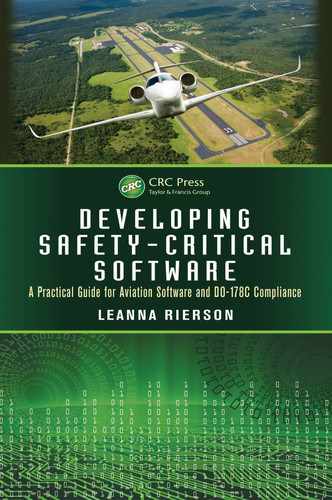Part III Developing Safety-Critical Software Using DO-178C
RTCA/DO-178C (referred to simply as DO-178C throughout this book) is entitled Software Considerations in Airborne Systems and Equipment Certification. It was developed as a set of recommendations through consensus of the international community* sponsored by RTCA† and EUROCAE‡ and was published on December 13, 2011. It is expected that the Federal Aviation Administration (FAA), European Aviation Safety Agency (EASA), and other civil aviation authorities will soon recognize this document as an acceptable means of compliance to the regulations.§ DO-178C and its EUROCAE equivalent (ED-12C) were preceded by DO-178/ED-12, DO-178A/ED-12A, and DO-178B/ED-12B. DO-178C provides guidance for developing airborne software; however, most of the guidance is also applicable to other safety-critical domains. Part III provides an overview of DO-178C, the differences from DO-178B to DO-178C, and the recommendations for developing software to comply with DO-178C. This section will not repeat what is included in DO-178C but will provide practical information on how to apply DO-178C to real projects.
At this time, the aviation industry is transitioning from DO-178B to DO-178C. Much of the guidance is common between the two versions of the document. Therefore, most of the dialogue in Part III applies to both DO-178B and DO-178C users. In anticipation of the transition to DO-178C, the term DO-178C is used throughout this book. Unless specifically noted as being different from DO-178B, the information will generally also apply to DO-178B users.
Part III is summarized as follows:
Chapter 4 provides a history of DO-178, an overview of DO-178C, a summary of the primary differences between DO-178B and DO-178C, and a summary of the six documents published with DO-178C.
Chapter 5 examines the DO-178C planning process and recommends best practices for effective planning.
Chapters 6, 7, and 8 discuss software requirements capture, design, and implementation, respectively. Each chapter explores what is required by DO-178C objectives and discusses recommendations for satisfying these objectives.
Chapters 9, 10, 11, and 12 examine the integral processes of verification, software configuration management, software quality assurance, and certification liaison, respectively. Again, these chapters will briefly discuss DO-178C objectives but will focus on practical ways to satisfy the objectives.
Chapters 6 (requirements) and 9 (verification) are longer than the other chapters due to the vital importance of these two subject areas to safety and DO-178C compliance.
*The joint committee included membership from industry, regulatory authorities, and academia from the United States, Canada, Europe, South America, and Asia.
†RTCA (formerly known as Radio Technical Commission for Aeronautics) is an association of both government and industry aviation organizations in the United States. RTCA receives some funds from the federal government but is also supported by annual fees from members and the sales of documents.
‡EUROCAE (European Organization for Civil Aviation Equipment) is an international organization whose membership is open to manufacturers and users in Europe of equipment for aeronautics, national civil aviation administrations, trade association, and, under certain conditions, non-European members.
§The recognition typically comes in the form of an Advisory Circular (AC) for the FAA and equivalent advisory materials by other certification authorities. It is expected that FAA AC 20-115C will be published to recognize DO-178C.
